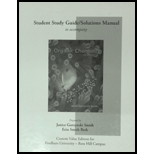
Concept explainers
(a)
Interpretation:The structure of glutamic acid exists at
Concept introduction:The glutamic acid belongs to the class of alpha amino acids. It is used in the biosynthesis of proteins. The molecular formula of glutamic acid is
(b)
Interpretation:The structures for the glutamic acid are formed by the addition of one, two and three equivalents of base are to be identified.
Concept introduction:The isoelectric point is the point where
(c)
Interpretation:The structure of monosodium glutamate is to be proposed.
Concept introduction:The glutamic acid belongs to the class of alpha amino acids. It is used in the biosynthesis of proteins. The molecular formula of glutamic acid is
Want to see the full answer?
Check out a sample textbook solution
Chapter 19 Solutions
Organic Chemistry -Study Guide / Solution Manual (Custom)
- (a) How many tripeptides can be made from glycine, alanine, and leucine, using each amino acid only once per tripeptide? (b) Write the structural formulas of these tripeptides and name them in the shorthand abbreviation used for showing amino acid sequences.arrow_forwardExplain the basic principle of the reaction between the amino acid histidine and the ninhydrin reagent.arrow_forwardPart A: Condensed structural formulas (ionized) of amino acids -glycine -alanine -serine Part B: Write the structure of the ionized form of phenylalanine.arrow_forward
- Which amino acids could be referred to as derivatives of butanoic acid? Give their structures. Draw the amino acid in zwitterion form. Draw one structure per sketcher. Add additional sketchers using the drop-down menu in the bottom right corner. Separate structures with + signs from the drop-down menu.arrow_forwardWhich of these molecules is not a natural amino acid?arrow_forwardA. Lysine is considered a basic amino acid containing a guanidino group. If all ionizable protons from lysine were deprotonated, what will be the overall charge for the lysine? B. Which of the following is true regarding amino acids? -Leucine and isoleucine have the same molecular mass. -Glycine is a chiral molecule. -Proline is considered to be an ⍺-amino acid. -Lysine (short for L) is a basic amino acid.arrow_forward
- Which of these amino acids has a hydrophobic side chain?arrow_forwardShow how L-Serine can act as buffer when you add H3O+ or OH- ions Write equations to show this.arrow_forwardDraw the structure of leu-enkephalin, a pentapeptide that acts as an analgesic and opiate, and has the following sequence: Tyr–Gly–Gly–Phe–Leu. (The structure of a related peptide, met-enkephalin, appeared in Section 22.6B.)arrow_forward
- Explain why casein precipitates when vinegar is added. Why was milk or raw egg once used as an antidote in cases of heavy metal poisoning? Based on your isolated yield of casein, how many grams of the protein are in one 200 g glass of milk? Which of the solutions contained amide bonds? Which test tells you this? Which of the solutions contained compounds with primary amino groups? Which test tells you this? Describe two examples of protein folding patterns and identify what level of protein structure they belong to. What other reagents might you use besides ferric chloride to test affinity for metal ions?arrow_forwardWhat are the intermolecular forces responsible for the folding of amino acid chains into proteins? Give specifics please.arrow_forwardWhat amino acid has an aryl group as a side chain?arrow_forward
- Chemistry: Matter and ChangeChemistryISBN:9780078746376Author:Dinah Zike, Laurel Dingrando, Nicholas Hainen, Cheryl WistromPublisher:Glencoe/McGraw-Hill School Pub Co
 World of ChemistryChemistryISBN:9780618562763Author:Steven S. ZumdahlPublisher:Houghton Mifflin College Div
World of ChemistryChemistryISBN:9780618562763Author:Steven S. ZumdahlPublisher:Houghton Mifflin College Div World of Chemistry, 3rd editionChemistryISBN:9781133109655Author:Steven S. Zumdahl, Susan L. Zumdahl, Donald J. DeCostePublisher:Brooks / Cole / Cengage Learning
World of Chemistry, 3rd editionChemistryISBN:9781133109655Author:Steven S. Zumdahl, Susan L. Zumdahl, Donald J. DeCostePublisher:Brooks / Cole / Cengage Learning  Chemistry: Principles and ReactionsChemistryISBN:9781305079373Author:William L. Masterton, Cecile N. HurleyPublisher:Cengage Learning
Chemistry: Principles and ReactionsChemistryISBN:9781305079373Author:William L. Masterton, Cecile N. HurleyPublisher:Cengage Learning Chemistry for Today: General, Organic, and Bioche...ChemistryISBN:9781305960060Author:Spencer L. Seager, Michael R. Slabaugh, Maren S. HansenPublisher:Cengage Learning
Chemistry for Today: General, Organic, and Bioche...ChemistryISBN:9781305960060Author:Spencer L. Seager, Michael R. Slabaugh, Maren S. HansenPublisher:Cengage Learning Introduction to General, Organic and BiochemistryChemistryISBN:9781285869759Author:Frederick A. Bettelheim, William H. Brown, Mary K. Campbell, Shawn O. Farrell, Omar TorresPublisher:Cengage Learning
Introduction to General, Organic and BiochemistryChemistryISBN:9781285869759Author:Frederick A. Bettelheim, William H. Brown, Mary K. Campbell, Shawn O. Farrell, Omar TorresPublisher:Cengage Learning





